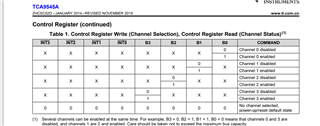Other Parts Discussed in Thread: TCA9545A
Hi Dear,
what is the difference between IIC switch and mux? If multiple IIC devices on the board have the same address, which type of material should I choose to resolve the conflict
This thread has been locked.
If you have a related question, please click the "Ask a related question" button in the top right corner. The newly created question will be automatically linked to this question.
Hi Clemens,
The configuration of TCA9544A and TCA9545A control registers is shown in the following figure. How can I understand it?
Can these two devices be connected to four devices with the same address?


The '44 can enable one channel at a time. The '45 can enable any combination of channels.
For your application, this difference does not matter, because you must never enable more than one channel. Both would work. (The software on the controller would be slightly different.)
Hi Clemens,
TCA9545A can enable four channels simultaneously. What application must TCA9545A be selected?
You would need a switch when you have bus segments that can be powered off or unplugged (so multiple segments powered on or plugged in at the same time are possible.)
Switches are more common than muxes, especially for 8-channel devices.
Hi Anna,
TCA9545A can enable four channels simultaneously. What application must TCA9545A be selected?
Yes. TCA9545A you can set each bit B3 - B0 in the control register byte during an I2C write to enable all channels at once.
TCA9544A is an I2C controlled MUX, meaning only one channel can be enabled at any given time.
Regards,
Tyler
Hi Tyler,
If it is to resolve address conflicts, can both TCA9545 and TCA9544A be implemented?
May I ask when it is necessary to enable multiple channels and when it is necessary to enable one channel? Does it depend on the customer's usage scenario?
Hi Anna,
If it is to resolve address conflicts, can both TCA9545 and TCA9544A be implemented?
TCA9544A has the first 4 bits fixed while TCA9545A has the first 5 bits fixed. Comparing the two devices, 9545A uses the same 4 fixed bits as the 9544.

TCA9544A has more selectable addresses allowing a maximum of 8 x TCA9544A on the same I2C bus without addressing issues.
TCA9545A has only two hardware selectable bits allowing for a maximum of 4 x TCA9545A's on the same I2C bus without addressing issues.
Technically, using both devices on the same I2C bus will still yield a maximum of 8 devices since the TCA9544A has a hardware selectable address bit A2.
May I ask when it is necessary to enable multiple channels and when it is necessary to enable one channel? Does it depend on the customer's usage scenario?
This is really dependent on the customer application. Sometimes, customer may want to reduce the number of times that the channels are switched on the I2C controlled switch. Therefore, instead of writing to the switch to enable & disable channels when talking to different target devices, the controller can simply enable multiple channels at a time saving on I2C bandwidth.
In the mux case, the controller will need to interface with the I2C mux enabling & disabling channels every time it wants to communicate to another I2C target device.
Regards,
Tyler